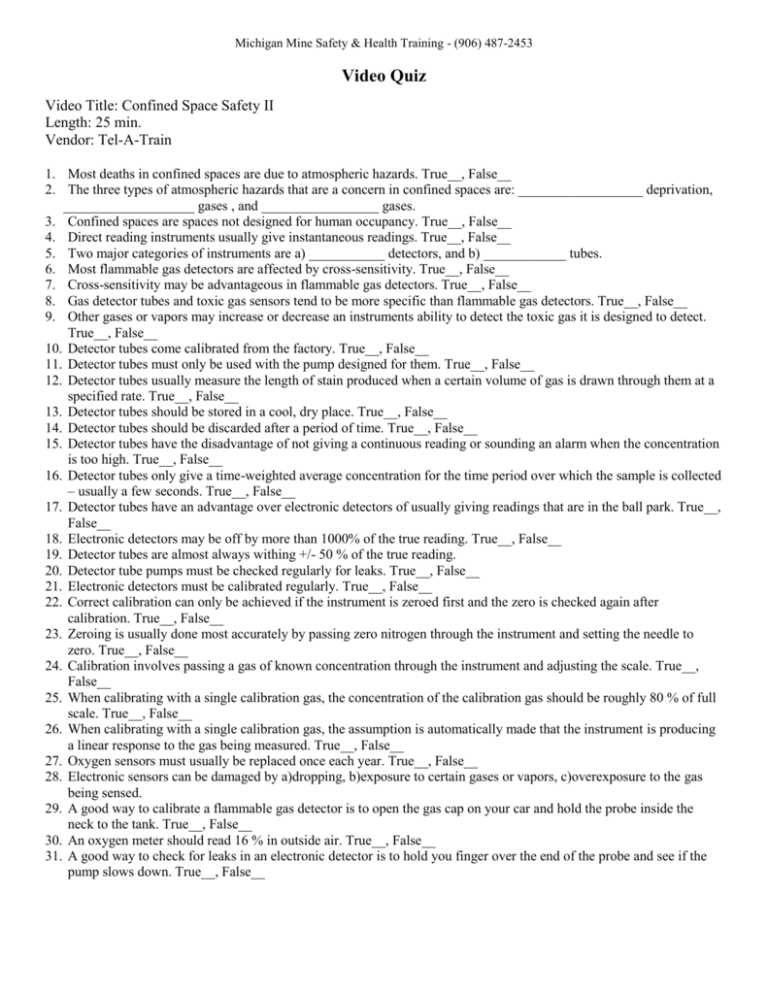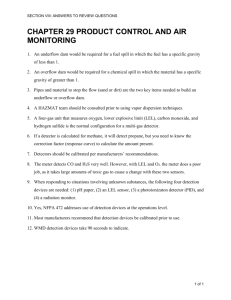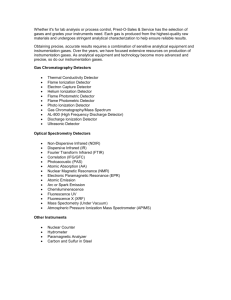Confined Space
advertisement

Michigan Mine Safety & Health Training - (906) 487-2453 Video Quiz Video Title: Confined Space Safety II Length: 25 min. Vendor: Tel-A-Train 1. Most deaths in confined spaces are due to atmospheric hazards. True__, False__ 2. The three types of atmospheric hazards that are a concern in confined spaces are: __________________ deprivation, ___________________ gases , and _________________ gases. 3. Confined spaces are spaces not designed for human occupancy. True__, False__ 4. Direct reading instruments usually give instantaneous readings. True__, False__ 5. Two major categories of instruments are a) ___________ detectors, and b) ____________ tubes. 6. Most flammable gas detectors are affected by cross-sensitivity. True__, False__ 7. Cross-sensitivity may be advantageous in flammable gas detectors. True__, False__ 8. Gas detector tubes and toxic gas sensors tend to be more specific than flammable gas detectors. True__, False__ 9. Other gases or vapors may increase or decrease an instruments ability to detect the toxic gas it is designed to detect. True__, False__ 10. Detector tubes come calibrated from the factory. True__, False__ 11. Detector tubes must only be used with the pump designed for them. True__, False__ 12. Detector tubes usually measure the length of stain produced when a certain volume of gas is drawn through them at a specified rate. True__, False__ 13. Detector tubes should be stored in a cool, dry place. True__, False__ 14. Detector tubes should be discarded after a period of time. True__, False__ 15. Detector tubes have the disadvantage of not giving a continuous reading or sounding an alarm when the concentration is too high. True__, False__ 16. Detector tubes only give a time-weighted average concentration for the time period over which the sample is collected – usually a few seconds. True__, False__ 17. Detector tubes have an advantage over electronic detectors of usually giving readings that are in the ball park. True__, False__ 18. Electronic detectors may be off by more than 1000% of the true reading. True__, False__ 19. Detector tubes are almost always withing +/- 50 % of the true reading. 20. Detector tube pumps must be checked regularly for leaks. True__, False__ 21. Electronic detectors must be calibrated regularly. True__, False__ 22. Correct calibration can only be achieved if the instrument is zeroed first and the zero is checked again after calibration. True__, False__ 23. Zeroing is usually done most accurately by passing zero nitrogen through the instrument and setting the needle to zero. True__, False__ 24. Calibration involves passing a gas of known concentration through the instrument and adjusting the scale. True__, False__ 25. When calibrating with a single calibration gas, the concentration of the calibration gas should be roughly 80 % of full scale. True__, False__ 26. When calibrating with a single calibration gas, the assumption is automatically made that the instrument is producing a linear response to the gas being measured. True__, False__ 27. Oxygen sensors must usually be replaced once each year. True__, False__ 28. Electronic sensors can be damaged by a)dropping, b)exposure to certain gases or vapors, c)overexposure to the gas being sensed. 29. A good way to calibrate a flammable gas detector is to open the gas cap on your car and hold the probe inside the neck to the tank. True__, False__ 30. An oxygen meter should read 16 % in outside air. True__, False__ 31. A good way to check for leaks in an electronic detector is to hold you finger over the end of the probe and see if the pump slows down. True__, False__ 32. Indicate by the letter U or D which gases will go up or go down in a confined space. a. Hydrogen (H2)-- ___ b. Methane (CH4) -- ___ c. Acetylene (C2H2)-- ___ d. Air -- ___ e. Hydrogen sulfide (H2S) --___ f. Benzene (C6H6) --____ g. Gasoline (Large molecule) -- ___ h. Propane (C3H8) -- ___ 33. It is important to test all heights and locations in a confined space. True__, False__ 34. Good ventilation is even better than testing to ensure that a confined space is safe. True__, False__ 35. Name two hazards to the person removing a cover from a confined space. ________________ and ____________________, 36. The maximum line length you should use when probing with an electronic instrument is about: a)10 feet, b)20 feet, c)40 feet, d)60 feet, e)80 feet. 37. An instrument that is introduced into a confined space should be ____________________ safe. 38. Oxygen is always adequate in a confined space because it diffuses so rapidly into the space when opened. True__, False__ 39. Symptoms of oxygen deprivation include a)depression, b)euphoria, c)headache, d)difficulty breathing, e)ringing in the ears, f)inability to make decisions. 40. Too much oxygen is a confined space is not a concern. True__, False__ 41. The minimum acceptable oxygen concentration in a confined space is: a) 21 %, b) 19.5 %, c) 18.5 %, d)16.5%, e)12.5%. 42. Oxygen in a confined space can be depleted by a)breathing, b)iron rusting, c)combustion, d)displacement. 43. Oxygen can collect in your clothing or in your hair making them very flammable. True__, False__ 44. Oxygen is a good substitute for air in ventilating a confined space. True__, False__ 45. Some flammable gas sensors will not work if the oxygen concentration is low. True__, False__ 46. Most flammable gas detectors measure the %LEL. True__, False__ 47. %LEL and volume % are the same. True__, False__ 48. Most flammable gas detectors alarm at 10% LEL. True__, False__ 49. If the needle on a flammable gas detector goes to the top of the scale and remains stable or fluctuates, you are likely in an explosive atmosphere. True__, False__ 50. If the needle goes to the top and drops to zero, you are likely in an explosive atmosphere. True__, False__ 51. It is important to know which flammable gases are likely to be present and how the detector responds to each. True__, False__ 52. Once you’re above the LEL, you have a high potential for an explosion, regardless of whether or not the UEL (upper explosive limit) is exceeded. True__, False__ 53. Hydrogen and acetylene are not detected by many flammable gas detectors. True__, False__ 54. To detect acetylene, a detector must be rated for Group A. True__, False__ 55. To detect hydrogen, a detector must be rated for Group B. True__, False__ 56. You should never use a flammable gas detector to test for toxics, even if it tests for carbon monoxide and hydrogen sulfide. True__, False__ 57. The two most common toxic gases in confined spaces are ______________________ and ____________________. 58. Carbon monoxide can be tasted and smelled. True__, False__ 59. Carbon monoxide asphyxiates a person. True__, False__ 60. The MSHA PEL (8 hour time weighted average exposure limit) for carbon monoxide is 50 ppm. True__, False__ 61. The MSHA PEL (8 hour time weighted average exposure limit) for hydrogen sulfide is 10 ppm. True__, False__ 62. Hydrogen sulfide smells like rotten eggs. True__, False__ 63. Hydrogen sulfide exposure rapidly deadens the person’s ability to smell it. True__, False__ 1)T, 2)oxygen, toxic, flammable, 3)T, 4)T, 5)electronic, detector, 6)T, 7)T, 8)T, 9)T, 10)T, 11)T, 12)T, 13)T, 14)T, 15)T, 16)T, 17)T, 18)T, 19)T, 20)T, 21)T, 22)T, 23)T, 24)T, 25)T, 26)T, 27)T, 28)a,b,c, 29)F—ruins the detector, 30)F – 21%, 31)T, 32)a)U, b)U, c)U, d)UD, e)D, f)D, g)D, h)D, 33)T, 34)T, 35)explosion, poisoning, 36)d, 37)intrinsically, 38)F, 39)b,c,d,e,f, 40)F—increases flammability, 41)b, 42)a,b,c,d, 43)T, 44)F, 45)T, 46)T, 47)F, 48)T, 49)T, 50)T, 51)T, 52)T, 53)T, 54)T, 55)T, 56)T – usually IDLH concentrations wouldn’t even be detected, 57)carbon monoxide and hydrogen sulfide, 58)F, 59)T – blood hemoglobin has much greater affinity for carbon monoxide than for oxygen molecules and the carbon monoxide molecules are not easily released, 60)T – 1973 TLVs, 61)T -- 1973 TLV, 62)T, 63)T





